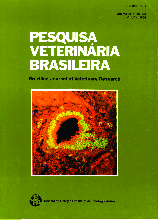 |
|
|
|
Year 2000 - Volume 20, Number 4
|

|
A retrospective search for bovine respiratory syncytial virus (BRSV) antigens in histological specimens by immunofluorescence and immunohistochemistry, 20(4):139-143
|
ABSTRACT.- Flores E.F., Weiblen R., Botton S.A., Medeiros M., lrigoyen L.F., Driemeier D., Schuch L.F. & Moraes M.S. 2000. A retrospective search for bovine respiratory syncytial virus (BRSV) antigens in histological specimens by immunofluorescence and immunohistochemistry. [Pesquisa retrospectiva de antígenos do Vírus Respiratório Sincicial Bovino (BRSV) em cortes histológicos por imunofluorescência e imunohistoquímica.] Pesquisa Veterinária Brasileira 20(4): 139-143. Depto Medicina Veterinária Preventiva, Universidade Federal de Santa Maria, 97105-900 Santa Maria, RS, Brazil.
Bovine respiratory syncytial vírus (BRSV) has been only sporadically identified as a causa tive agent of respiratory disease in Brazil. This contrasts with frequent reports of clinical and histopathological findings suggestive of BRSV-associated disease. In order to examine a possible involvement of BRSV in cases of calf pneumonia, a retrospective search was performed for BRSV antigens in histological specimens submitted to veterinary diagnostic services from the states of Rio Grande do Sul and Minas Gerais. Ten out of 41 cases examined (24.4%) were positive for BRSV antigens by immunohistochemistry (IPX). Eight of these cases (19.5%) were also positive by indirect immunofluorescence (IFA), and 31 cases (75.6%) were negative in both assays. In the lungs, BRSV antigens were predominantly observed in epithelial cells of bronchioles and less frequently found in alveoli. In one case, antigens were detected only in the epithelium of the alveolar septae. The presence of antigen-positive cells was largely restricted to epithelial cells of these airways. In two cases, positive staining was also observed in cells and cellular debris in the exudate within the pulmonary airways. The clinical cases positive for BRSV antigens were observed mainly in young animals (2 to 12 month-old) from dairy herds. The main microscopic changes included bronchointerstitial pneumonia characterized by thickening of alveolar septae adjacent to airways by mononuclear cell infiltrates, and the presence of alveolar syncytial giant cells. In summary, the results demonstrate the suitability of the immunodetection of viral antigens in routinely fixed tissue specimens as a diagnostic tool for BRSV infection. Moreover, the findings provide further evidence of the importance of BRSVas a respiratory pathogen of young cattle in southeastern and southern Brazil. |
| |
|
|
| |
|
 |